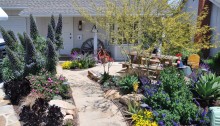 |
Saving Water OutdoorsOf the estimated water used daily by households in the United States, nearly 30 percent, is devoted to outdoor water use. In the hot summer months, or in dry climates, a household’s outdoor water use can be as high as 70 percent. Taking some time to evaluate outdoor water usage around your home. By coming up with a plan to modify some watering habits and adjust your homes landscaping design you can dramatically lower your water consumption and still maintain a beautifully natural looking environment. |
 |
Irrigation/Sprinkler System Tips
|
Your Front & Back Yard
Create a water-smart landscape that is both beautiful and water efficient to give your home the curb appeal you desire.
Remember timing is critical when watering. By knowing when and how much to water you will know how to keep a healthy landscape with just the right amount of water and even the best times of day to water. It’s recommended to upgrade to a “Smart” irrigation / sprinkler watering controller if you have an in-ground irrigation system.
 Use regionally appropriate, low water-consuming and native plants.
Use regionally appropriate, low water-consuming and native plants.
Once established, these plants require little water beyond normal rainfall. Also, because native plants are adapted to local soils and climatic conditions, they rarely require the addition of fertilizer and are more resistant to pests and diseases than are other species. Be careful when selecting exotic species, as some may be invasive, which may require more water and could displace native plants.
Group plants according to their water needs.
Grouping vegetation with similar watering needs into specific “hydrozones” reduces water use and protects the plants from both underwatering and overwatering by allowing you to water to each zone’s specific needs. For example, turf areas and shrub areas should always be separated into different hydrozones because of their differing water needs.
Recognize site conditions and plant appropriately.
Areas of the same site may vary significantly in soil type or exposure to sun and wind, as well as evaporation rates and moisture levels. Be mindful of a site’s exposure to the elements and choose plants that will thrive in the site’s conditions.
“Pick plants that grow only to the size you want them,” advises Margaret Grace, principal of Grace Design Associates in Santa Barbara, Calif. “If you need five-foot-high screening between you and a neighbor, don’t put in something that grows nine feet high. You’ll have to chop it back all the time.” That’s a huge waste of water, not to mention extra work.
Trees and shrubs need extra water the first couple of years to help their roots take hold. An efficient way to keep them moist is to mound several inches of soil into a donut-shape berm out about as far as the branches reach. Use a hose or bucket to fill the donut dam to the top. Water will absorb slowly instead of running off. Another option: Attach a $25 – $30 drip irrigator bag to the tree.
Mulch to reduce evaporation
Putting two or three inches of mulch on top of the soil around your plants is a great way to reduce water loss. Mulch also cuts down on water-stealing weeds. The best mulch options are natural ones like compost, bark chips, and pine needles. These organic mulches gradually break down and add nutrients to the soil. Inorganic materials like rocks and pebbles are a more permanent option, although in some climates they can hold too much heat. A quick tip: Don’t pile mulch up in huge cones against a plant’s stem or it will trap too much moisture, which leads to fungus and rot.
Make paths porous
Paths made of pebbles, gravel, or non-mortared concrete pavers or brick allow water to percolate down to your plants’ roots instead of running off into a storm drain. No mortar does mean more room for weeds to grow, though.
Plant and water when it’s cool
New plants and transplants need far less water if you put them in the ground in early fall or early spring, when it’s cooler. Similarly, water in the morning so you’ll lose less to evaporation in the heat of the day.
Other outdoor activities
- Trade the water hose for the broom – Sweep driveways, sidewalks, and steps rather than hosing off.
- Wash your car with water from a bucket and use a hose spray nozzle with an on/off trigger or consider using a commercial car wash that recycles water.
- If you have a pool, it’s recommended that you use a pool cover to reduce evaporation when pool is not being used. Besides the benefit of using less water. The cover will also stabilize warm water temperature, keep the pool cleaner and require less chlorine or other chemicals or filtering time to keep clean and ready for use.
Quick Links to Products mentioned in this article
 |
drip irrigation systems |
 |
“smart” irrigation/watering system controllers |
 |
sprinkler heads |
 |
mulch compost bark chips |
Info Source:
EPA.gov
HouseLogic
